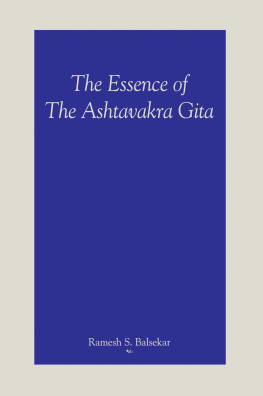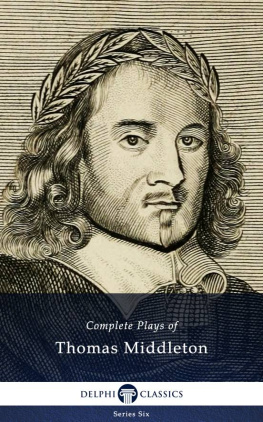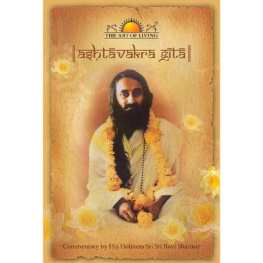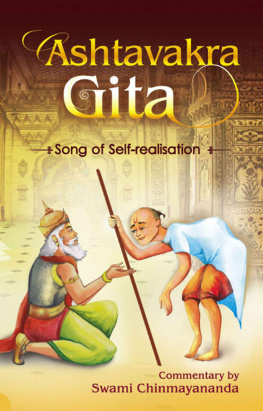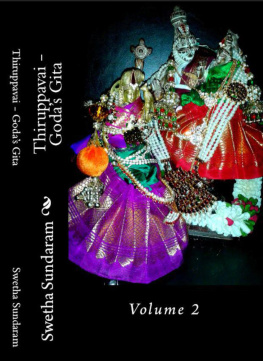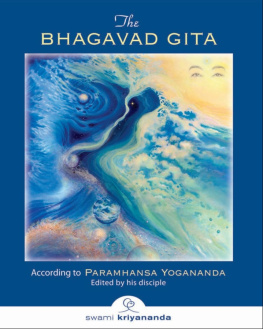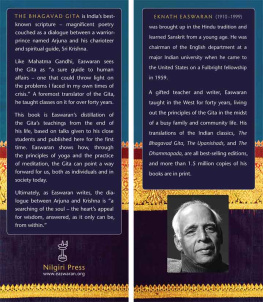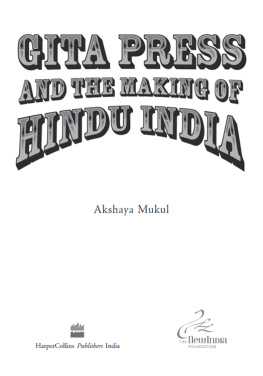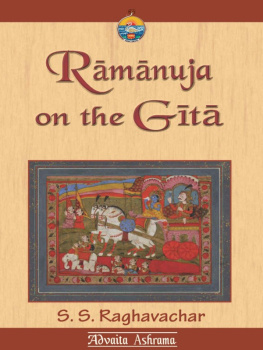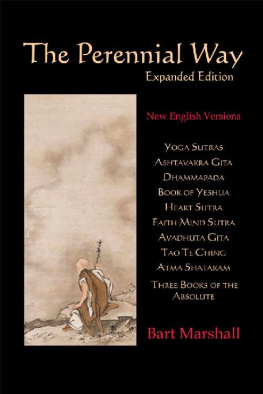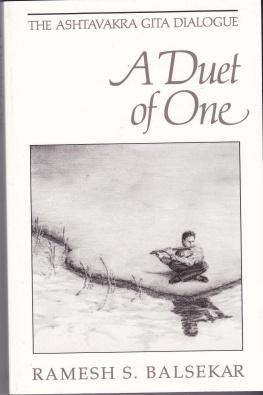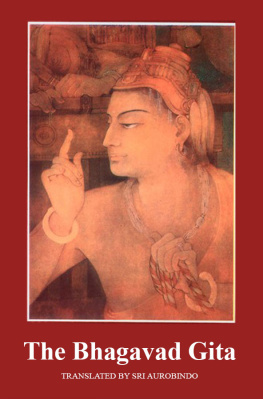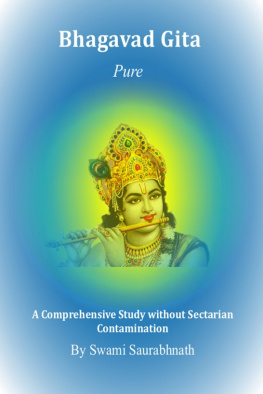Middleton - The essence of the Ashtavakra Gita
Here you can read online Middleton - The essence of the Ashtavakra Gita full text of the book (entire story) in english for free. Download pdf and epub, get meaning, cover and reviews about this ebook. City: Chesapeake Bay (Md. and Va.), Maryland, Virginia, Virginia., Maryland., Atlantic Ocean--Chesapeake B, year: 1953, publisher: Zen Publications, genre: Religion. Description of the work, (preface) as well as reviews are available. Best literature library LitArk.com created for fans of good reading and offers a wide selection of genres:
Romance novel
Science fiction
Adventure
Detective
Science
History
Home and family
Prose
Art
Politics
Computer
Non-fiction
Religion
Business
Children
Humor
Choose a favorite category and find really read worthwhile books. Enjoy immersion in the world of imagination, feel the emotions of the characters or learn something new for yourself, make an fascinating discovery.
- Book:The essence of the Ashtavakra Gita
- Author:
- Publisher:Zen Publications
- Genre:
- Year:1953
- City:Chesapeake Bay (Md. and Va.), Maryland, Virginia, Virginia., Maryland., Atlantic Ocean--Chesapeake B
- Rating:3 / 5
- Favourites:Add to favourites
- Your mark:
- 60
- 1
- 2
- 3
- 4
- 5
The essence of the Ashtavakra Gita: summary, description and annotation
We offer to read an annotation, description, summary or preface (depends on what the author of the book "The essence of the Ashtavakra Gita" wrote himself). If you haven't found the necessary information about the book — write in the comments, we will try to find it.
The essence of the Ashtavakra Gita — read online for free the complete book (whole text) full work
Below is the text of the book, divided by pages. System saving the place of the last page read, allows you to conveniently read the book "The essence of the Ashtavakra Gita" online for free, without having to search again every time where you left off. Put a bookmark, and you can go to the page where you finished reading at any time.
Font size:
Interval:
Bookmark:
The Essence of
The Ashtavakra Gita
Ramesh S. Balsekar

Copyright 2006 by Ramesh S. Balsekar
PUBLISHED BY
ZEN PUBLICATIONS
60, Juhu Supreme Shopping Centre,
Gulmohar Cross Road No. 9
JVPD Scheme, Juhu, Mumbai 400 049. India.
Tel: +91 22 32408074
eMail.
Website. www.zenpublications.com
Cover & Book Design by Red Sky Designs
ISBN 978-81-88071-91-3
All rights reserved. No part of this book may be reproduced or transmitted in any means, electronic or mechanical, including photocopying, recording, or by any information storage and retrieval system without written permission from the Publisher, except for the inclusion of brief quotations in a review.

Contents
Preface
A clearly seen feature of Eastern scriptures is the recurring repetition of the basic Truth in its different aspects, detailed in different words and with different illustrations and examples. The intention is to give a reasonable chance to the disciple with the least intelligence.
In the Ashtavakra Gita also, a considerable amount of repetition is found. One specific advantage of such repetition is that for some mysterious reason, a certain statement will have a sudden impact on a particular person at a particular moment, even though that statement may have been repeated several times earlier. And even for those who have already understood something very clearly, a particular statement made in a particular context often brings out a subtle aspect which had earlier escaped their attention. It is therefore important not to take a repetition lightly as a mere repetition. It is important to remember that when the guru makes a statement, it comes out of his lips spontaneously at that kshana or split-second. For him it is not a repetition, and therefore it has a certain special significance in regard to a particular context or circumstance. It is important to listen to every statement of the guru as a fresh lesson, and not to ignore it as a mere repetition. Even good music is listened to over and over again, and great sensual pleasure is derived from such music. How much more important it must be to listen to the Truth from the gurus lips over and over again even though it is the same Truth!
Indeed, life itself is a rotating repetition. Day in and day out, year in and year out, there is repetition: morning, noon, evening and night; summer, autumn, winter and spring. But each has its own aspects which are rarely similar in every respect to the earlier ones.
Chapter One
T here is an ancient treatise in Sanskrit some scholars consider it older than the Bhagavad Gita called Ashtavakra Gita which consists of a dialogue between the sage Ashtavakra and his disciple King Janaka. This dialogue provides an extraordinary instance of the divine element in the relationship between a Self-realized guru and a superbly ripe disciple, i.e. one who is just waiting for that one quick spark of initiation into Truth that brings about sudden enlightenment. The Ashtavakra Gita at the same time provides an astonishingly direct, positive and unequivocal exegesis of the doctrine of non-duality, perhaps the best that has ever been done.
The Ashtavakra Gita is not nearly so well known as the Bhagavad Gita for the very reason that it is so specifically clear and unambiguous that it does not lend itself to the twists and turns required by commentators to justify their own philosophical pre-possessions or spiritual leanings. It contains superbly authoritative statements and clear assertions, so obviously based on intuitive experience and conviction as to deny and utterly negate any effort at exegetic ingenuity or intellectual acrobatics. It is a comparatively small treatise, compact and well-knit, containing about 300 verses of two lines, conveying the Truth, the whole Truth, and nothing but the Truth.
The sage Ashtavakra was so called because he had eight curves or deformities in his body. There are differing accounts concerning the deformities. One legend has it that when Ashtavakra was in his mothers womb, his father used to recite the Vedas every day, and Ashtavakra used to hear them so recited. The father, though a devout and pious man, was not a very scholarly man and thus used to commit a number of mistakes in reciting the Vedas; and Ashtavakra, already highly mature spiritually, could not bear to hear the Vedas so badly recited with the result that he could not help squirming in his mothers womb and thereby becoming deformed in eight places.
There is another legend in the Mahabharata that Ashtavakras father named, Kahor, used to recite the Vedas to his wife Sujata when their child was in Sujatas womb. The child, one day, suddenly cried out Through your grace, my dear father, I have learnt all the Vedas, but it is a pity that you commit several mistakes in your pronunciation. Kahor, a great scholar (according to this version) and renowned for his learning, could not bear this insult from his unborn child, and cursed him that he would be born with eight curves in his body, and thus was born Ashtavakra, eight-curved.
The story continues that Ashtavakras father, Kahor, went to the court of King Janaka in order to obtain some favor, and was asked to debate on spiritual matters with the court scholar named Vandin who was the son of King Varuna. Kahor was defeated and as a result was banished to the netherworld as a priest at a sacrifice being performed by Varuna. When Ashtavakra was twelve years old, he heard of his fathers plight and went to the court of King Janaka in order to participate in a general debate where the most renowned scholars were invited. Ashtavakra found it difficult to get entrance into the court, but finally managed to do so. When the assembly saw Ashtavakra waddling into the court, all the assembled scholars began to laugh, even the kindly and pious King Janaka could not suppress a smile, but his amusement turned into astonishment when he saw that young Ashtavakra was laughing as loudly as anyone else. The king turned to the little deformed character and said to him, Young man, I can understand why the others are laughing, but I cannot understand the cause of your laughter. Ashtavakra suddenly became serious and told the king that he was laughing because he could not understand how the king could expect to find Truth in an assembly of cobblers. Now the king was angry, and gravely asked Ashtavakra to explain himself. The young lad answered equally gravely, It is simple, your Majesty. All these honored guests are no better than cobblers because they cannot see beyond the skin. They cannot see the Presence within the physical body. If the earthen pot is broken, does the space within get broken? If the pot is misshapen, does the space within get misshapen? My body may be deformed but I am infinite and limit less. The king, already highly advanced spiritually, knew at once that Ashtavakra was a completely Self-realized soul, and the very next day, at his request, he was accepted by Ashtavakra as a disciple.
This story of Ashtavakra, like others concerning many other saints and sages and prophets is obviously not to be taken literally. It is not difficult to see the real significance of this story, as in the case of similar stories concerning other sages and prophets like the Buddha and Lao Tzu and Zarathustra. In the case of Ashtavakra, the deformation of the body in eight places could have a reference to the eightfold path of Yoga. Ashtavakra avers that enlightenment does not really need any practices and disciplines of body or mind. Enlightenment can be sudden and can occur in a split-second as soon as there is clear realization (not a mere intellectual understanding) that there never has been any bondage for anyone, that one is always free, that freedom has always been ones birth right.
Next pageFont size:
Interval:
Bookmark:
Similar books «The essence of the Ashtavakra Gita»
Look at similar books to The essence of the Ashtavakra Gita. We have selected literature similar in name and meaning in the hope of providing readers with more options to find new, interesting, not yet read works.
Discussion, reviews of the book The essence of the Ashtavakra Gita and just readers' own opinions. Leave your comments, write what you think about the work, its meaning or the main characters. Specify what exactly you liked and what you didn't like, and why you think so.

